Since President Trump took office at the end of January, he has signed twenty-two executive actions. While some seem to be relatively straightforward, others have caused controversy across the public and private sector. If you are a government employee and are a little confused about what some of these executive actions mean for you, you are not alone.
We recently broke down what exactly an executive order is but we wanted to further break down what some of the executive actions most relevant to govies mean and highlight the important parts of the text of each action. In this post, we’ll focus on the federal hiring freeze.
However, before we dive into the hiring freeze, it’s important to know the difference between the three executive actions the president can take. Executive orders are the most commonly referenced and hold the most authority. They are similar to laws passed by Congress and instruct how the government should operate within the law. Presidential memoranda hold the second most weight and have a similar legal effect however, they are more of a suggestion to prompt action instead of directing it. Proclamations can hold as much weight as the other executive actions but they are more ceremonial observances of holidays or awareness months.
In the past few weeks, President Trump has signed eight executive orders, twelve presidential memoranda, and two proclamations. While many have been referring to the federal hiring freeze as an executive order, it is actually a presidential memoranda. While the differences between executive orders and presidential memoranda are few, this means that the federal hiring freeze memoranda doesn’t have an official records number, nor is it published in the Federal Register.
The White House released the Presidential Memorandum Regarding the Hiring Freeze on January 23, 2017. Here are some of the highlights from the text of the memorandum:
- The freeze prohibits filling vacant positions or creating new positions after noon on January 22, 2017. However, the language of the memorandum states that the freeze does not include or apply to military personal. Additionally, a vacant head of an executive department may be filled during the hiring freeze if filling the position is deemed necessary to ensure national security or public safety. Finally, the Director of the Office of Personnel Management (OPM) may grant necessary exemptions to the freeze.
- After 90 days, the Director of the Office of Management and Budget (OMB) and the Director of OPM will recommend a long-term plan to reduce the overall size of the federal government. Once that plan is implemented, the presidential memorandum will expire.
- The memorandum prohibits agencies from using outside contractors to circumvent the intent of the memorandum but does not indicate the consequences for doing so. Additionally, the memorandum applies to all executive departments and agencies regardless of where they get their funding from.
- The memorandum does not prohibit agencies from making reallocations to meet the needs in the agency. President Trump asks agencies to efficiently use existing personnel and funds to improve public services.
- Finally, the positions excluded from the freeze include positions that require Presidential appointment or Senate confirmation, the appointment of officials to non-career positions in the SES, or to Schedule C positions in the Excepted Service.
For more information and interpretations of the hiring freeze check out these additional resources:
- Trump’s Federal Hiring Freeze Won’t Kill Government IT Hiring
- Pentagon Orders 16 Specific Exemptions to Federal Hiring Freeze
- In Latest Guidance, OMB Lists Agency Exemptions from Trump’s Hiring Freeze
- DoD Exempts Cyber from Trump’s Hiring Freeze
- What Does a Hiring Freeze Mean for the Federal Workforce





Leave a Reply
You must be logged in to post a comment.